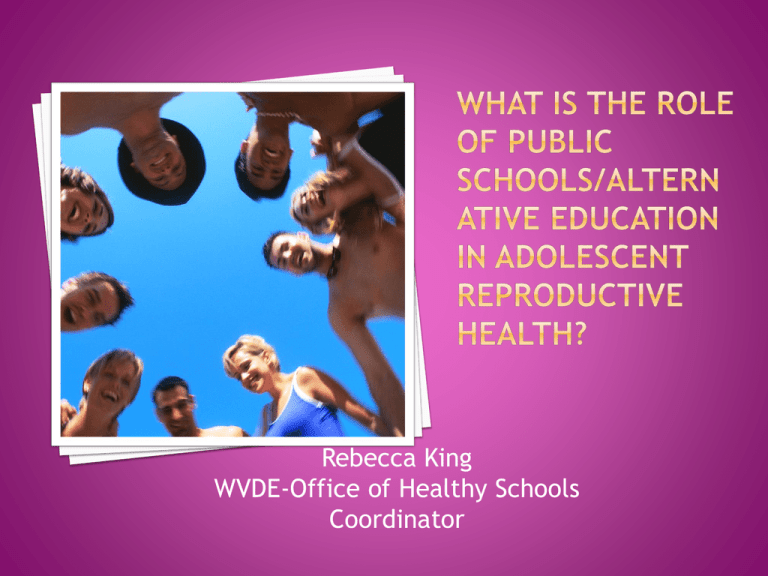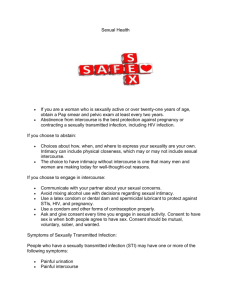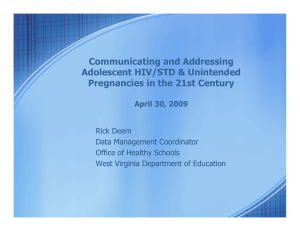Rebecca King WVDE-Office of Healthy Schools Coordinator
advertisement

Rebecca King WVDE-Office of Healthy Schools Coordinator W.V. State Code and WVBE Rules Health and Counseling Services YRBS Required Courses of Instructionrequires health education in grades six through twelve to educate on the prevention, transmission and spread of acquired immune deficiency syndrome and other sexually transmitted diseases. Allows for parents and guardians to examine the course curriculum requirements and materials. The parent or guardian may exempt the child from participation in such instruction in giving written notice to the school principle. Requires AIDS in-service training programs for all school personnel with encouraged attendance of parents. Policy 2423-Communicable Disease Requires instruction on the principle modes by which communicable diseases, including, but not limited to, human immunodeficiency virus (HIV)/acquired immunodeficiency syndrome (AIDS) are prevented, spread and transmitted shall be taught to students as outlined in 126CSR44E West Virginia Board of Education Policy 2520.5, Health Content Standards and Objectives. An opportunity shall be afforded to the parent or guardian of a child subject to instruction in the prevention, transmission and spread of HIV/AIDS and other sexually transmitted diseases to examine the course curriculum requirements and materials to be used in such instruction. The parent or guardian may exempt such child from participation in such instruction by giving notice to that effect in writing to the school principal as set forth in W. Va. Code §18-2-9. Policy 2423-Communicable Disease An educational in-service on the prevention, transmission and treatment of current communicable diseases shall include, but not limited to, human immunodeficiency virus (HIV) and acquired immune deficiency syndrome (AIDS), shall be provided to all school personnel every two years by the county boards of education, as specified in W. Va. Code §18-2-9 and §l8- 5-l5d. Health Content Standards and Objectives for Grades 5-12 This policy defines the content standards (or instructional goals) and objectives for the program of study required by Policy 2510 in health. A major focus has been given to what the Center for Disease Control recognizes as adolescent risk behaviors (tobacco use, dietary patterns contributing to disease, sedentary lifestyle, sexual behaviors that result in HIV infection/other STDs and unintended pregnancy, alcohol and other drug use, and behaviors that result in intentional and unintentional injury). Standard 1: Standard 2: Standard 3: Standard 4: Standard 5: Standard 6: Standard 7: Standard 8: Health Promotion & Disease Prevention Culture, Media, and Technology Health Information and Services Communication Decision Making Goal Setting Health Behaviors Advocacy All WVDE adopted textbooks met the criteria to include HIV/AIDS and STDs. Established in 1990 to monitor priority health risk behaviors that contribute to the leading causes of death, disability, and social problems among youth and adults in the United States. These behaviors include: • Tobacco use. • Unhealthy dietary behaviors. • Inadequate physical activity. • Alcohol and other drug use. • Sexual behaviors that contribute to unintended pregnancy and sexually transmitted diseases, including HIV infection. • Behaviors that contribute to unintentional injuries and violence. The YRBS was designed to: • • Determine the prevalence of health risk behaviors. Assess whether health risk behaviors increase, decrease, or stay the same over time. • Examine the co-occurrence of health risk behaviors. • Provide comparable national, state, and local data. • Provide comparable data among subpopulations of youth. Monitor progress toward achieving the Healthy People 2010 objectives and other program indicators. • SEXUAL BEHAVIOR AND SEXUALITY EDUCATION The percentage of students who had sexual intercourse for the first time before age 13 decreased from 7.3% in 2003 and 2005 to 6.0% in 2009. The percentage of students who have ever had sexual intercourse increased from 52.0% in 2003 to 54.1% in 2009. Students who had sexual intercourse with four or more people during their life decreased from 16.5% in 2003 to 14.8% in 2005, and then increased to 15.5% in 2009. Of the students who had sexual intercourse during the past three months, the percentage who drank alcohol or used drugs before last sexual intercourse decreased from 24.6% in 2003 to 20.7% in 2005, and then increased to 22.3% in 2009. Among the students who had sexual intercourse during the past three months, the percentage who used birth control pills decreased from 24.6% in 2003 to 24.0 in 2005, and then increased to 23.1% in 2009. The percentage of students who say they have ever been taught in school about AIDS or HIV increased from 88.9% in 2003 to 89.6%, and then decreased to 86.3% in 2009. The percentage among sexually active adolescent who had sexual intercourse during the past three months who used a condom during the last sexual intercourse was 64.7% in 2003 and then decreased significantly to 54.4% in 2009. 2008-09 Growth and Development High School Average Score - 71% To view the HEAP scores in your schools, go to http://wvde.state.wv.us/osshp/main/HEAP.htm Basic counseling for questions Encouragement to speak with parents Provide valid resources and referrals WV PIN (West Virginia Prevention Information Network) http://www.wvpin.net/ Informing Parents Pregnancy Test Transportation to Family Planning Clinics Peer Education EBIs ?????? Rebecca King (304) 558-8830 rjking@access.k12.wv.us http://wvde.state.wv.us/osshp/main/




